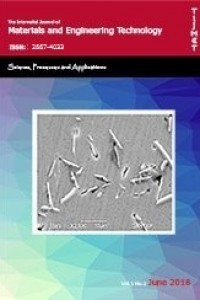INVESTIGATION OF EFFECT OF PRE-CONSUMER RECYCLING ACRYLIC FIBER RATIO ON YARN AND FABRIC PROPERTIES
INVESTIGATION OF EFFECT OF PRE-CONSUMER RECYCLING ACRYLIC FIBER RATIO ON YARN AND FABRIC PROPERTIES
European Green deal, pre-consumer, acrylic, recycling, yarn,
___
- Referans [1]. Palamutçu, S., Textiles and clothing sustainability sustainable technologies, 2017, Edited by S. S. Muthu, Springer, Hong Kong Limited.
- Referans [2]. Lenzing, https://www.lenzing.com/
- Referans [3]. Voncina, Bojana. Recycling of textile materials. MDT Recycl. 2016, 1:1-37.
- Referans [4]. Beton, A., Dias, D., Farrant, L., Gibon, T., Le Guern, Y., Desaxce, M., & Dodd, Environmental improvement potential of textiles (IMPRO-Textiles). European Commission. 2014.
- Referans [5]. Ütebay, B., Çelik, P., Çay, A., Effects of cotton textile waste properties on recycled fibre quality, Journal of Cleaner Production. 2019, 222:29-35.
- Referans [6]. P. Senthil Kumar, P. S., and Yaashikaa, P. R., Sustainable innovations in recycled textiles, 2018, Edited by S. S. Muthu, Springer, Hong Kong Limited.
- Referans [7]. Gun Demiroz, A., Kuyucak, C. N., Performance properties of plain knitted fabrics made from open end recycled acrylic yarn with the effects of covered and PBT elastic yarns. Fibers and Polymers. 2022, 23(1):282-294.
- Referans [8]. Gun Demiroz, A., Yigit, E. S., Evaluation of unevenness and tensile properties of open-end yarns produced by recycled acrylic-based textile wastes from different sources. Journal of ASTM International. 2021, 50(1):1-13.
- Yayın Aralığı: Yılda 2 Sayı
- Başlangıç: 2018
- Yayıncı: Necip Fazıl YILMAZ
Ömer EYERCİOĞLU, Engin TEK, Mehmet ALADAĞ
FABRICATION AND WELDING OF ALUMINUM COMPOSITE
Wafa MELİK, Zakaria BOUMERZOUG, Fabienne DELAUNOİS
RESEARCH ON THE ELECTRICAL EFFECT OF FERROMAGNETIC MATERIAL ON THE COIL
Mehmet Ali ÖZÇELİK, Ahmet AYCAN
INVESTIGATION OF EFFECT OF PRE-CONSUMER RECYCLING ACRYLIC FIBER RATIO ON YARN AND FABRIC PROPERTIES
Esin SARIOĞLU, Serdar SAYCAN, Perihan TEKİN, Halil İbrahim ÇELİK, Hatice Kübra KAYNAK
INVESTIGATION OF THE HEAT AFFECTED ZONE BY THERMAL CYCLE SIMULATION TECHNIQUE
Zakaria BOUMERZOUG, Fabienne DELAUNOİS, Oualid BEZİOU, Ines HAMDİ
A COMPARATIVE STUDY OF BRAKE WEAR PERFORMANCE WITH RECENT COATING METHODS
Recep AKYÜZ, Ekrem ALTUNCU, Çiğdem DİNDAR, Hakan AYDIN
Altuğ UŞUN, Recep GÜMRÜK, Nuri YILDIZ, Bahri Barış VATANDAŞ
YARN QUALITY INVESTIGATION OF COMPACT COTTON YARNS WITH DIFFERENT COMBING NOIL PERCENTAGE
